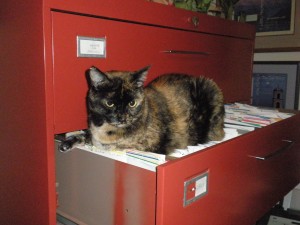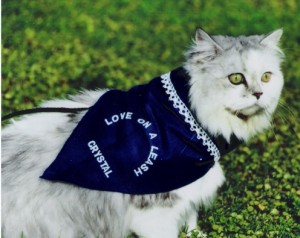
IM000252.JPG
While I was earning my living as a freelance article-writer, I happened across a fascinating topic—working cats. And I wrote a couple of articles featuring some of the working and library cats across the US.
You probably know of a cat or two who hang out at a pet store, garden center, flower shop, quilt shop, refinishing shop, your vet’s office, or even a bed and breakfast. There are actually 470 known shop cats throughout the states, according to Trina Samson, who’s been operating the Shop Cat website at http://www.shopcat.com for at least fifteen or twenty years. Visit this site and find out some of the interesting and unique places where cats work.
Here in Ojai, CA, we see a resident cat lurking about at a feed store, and there was one  greeting customers at a unique outdoor bookstore for many years. I love eating at a particular restaurant in Big Sur where cats grace the place. There are also lodges and inns where you can request a cat for your room if you so desire.
greeting customers at a unique outdoor bookstore for many years. I love eating at a particular restaurant in Big Sur where cats grace the place. There are also lodges and inns where you can request a cat for your room if you so desire.
There are 809 library cats in the world—664 in the US and over 400 former library cats in the US who have since passed on. You’ve probably heard of the most famous library cat of all—Dewey. I was among the first to write about Dewey, years ago. The librarian, when she retired, made him even more famous when she came out with a book about this cat. Check out the list of library cats here: http://www.ironfrog.com
There are advantages to having a cat in the workplace and public places, but also disadvantages. Cats are known to have a calming effect on people. Some employers actually allow people to bring their pets to work. In some instances, the employer adopts a relaxed, quiet cat from a shelter and gives him the run of the office. The cat’s job is to provide a serene atmosphere in even busy, hectic businesses. Cats are often brought into warehouses to work as mousers.
It has been shown that customers will stay longer and, perhaps, buy more in a business  where there’s a friendly cat. A cat in the workplace is also an advantage for a cat who has no place else to go. Many of the business and shop owners I spoke to while writing about shop cats and library cats said that the cat strayed in, or they found the cat wandering the streets. Some purposely rescued cats from local shelters. And others bring their own cat back and forth from home to work.
where there’s a friendly cat. A cat in the workplace is also an advantage for a cat who has no place else to go. Many of the business and shop owners I spoke to while writing about shop cats and library cats said that the cat strayed in, or they found the cat wandering the streets. Some purposely rescued cats from local shelters. And others bring their own cat back and forth from home to work.
The disadvantages to having a cat in a public place or business is the obvious—some people dislike and even fear cats. There are people with cat allergies. I was involved in a cat therapy program once. We’d take kittens from a shelter into nursing homes. At one place, I was confronted by a scary employee who was deathly afraid of cats—even kittens. She’d run away screaming whenever I’d walk into the place with a kitten. Certainly, that woman would never knowingly set foot in a business or public building with a cat. I talked to some librarians and business owners who say they will lock the cat up in such cases.
Tomorrow we’ll talk about cats in the White House and famous people in history who owned cats.





